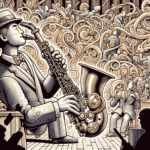The clarinet, typically associated with classical music, boasts a fascinating journey through jazz history. From the bustling streets of New Orleans to today's sophisticated jazz clubs, this instrument has grown and changed with the genre, producing a variety of unique voices and remarkable talents. Join us as we explore the notable clarinet players who've left their mark on jazz, showcasing their unique styles, memorable performances, and lasting impact.
The Birth of the Jazz Clarinet
The clarinet found its place in jazz during the genre's early days in the 20th century, especially in New Orleans. Musicians favored it for its warm sound and wide range, which offered both melodic and harmonic possibilities. As jazz expanded, many clarinetists emerged, each adding their personal touch to the music.
Key Figures in Clarinet History
Several clarinet players have significantly impacted jazz music. Here are some of the most influential:
| Clarinetist | Notable Contributions | Signature Style |
|---|---|---|
| Sidney Bechet | Pioneer of New Orleans jazz style | Powerful, expressive sound |
| Benny Goodman | King of Swing, integrated bands | Impeccable technique, rhythmic precision |
| Artie Shaw | Expanded clarinet's jazz territories | Sophisticated orchestration, classical influences |
| Jimmy Hamilton | Member of Duke Ellington's orchestra | Beautiful tone, inventive improvisation |
| Pee Wee Russell | Influenced many future musicians | Distinctive sound, blues and gospel influences |
1. Sidney Bechet
Sidney Bechet, one of jazz's first important soloists, was known for his virtuosic skills and a sound that was both powerful and expressive. Bechet, who played the clarinet and soprano saxophone, was a pioneer of the New Orleans jazz style and helped popularize the clarinet as a lead instrument. His improvisational skill and ability to convey deep emotion through music paved the way for future generations of clarinetists.
2. Benny Goodman
Known as the ‘King of Swing', Benny Goodman brought the clarinet to the forefront of the big band era. His flawless technique and rhythmic precision amazed audiences, and his band was one of the first to include both black and white musicians, reflecting the changing face of American music. Goodman's unforgettable performances and recordings of pieces like ‘Sing, Sing, Sing' showcase his innovative approach and influence.
3. Artie Shaw
Another key figure in the swing era, Artie Shaw took the clarinet in new directions. Known for his excellent taste in orchestration and arrangements, Shaw's style was characterized by sophistication and flair. His popular hit, ‘Begin the Beguine', demonstrated his unique blend of classical and jazz influences, further broadening the audience for clarinetists in jazz.
4. Jimmy Hamilton
A key member of Duke Ellington's orchestra, Jimmy Hamilton was celebrated for his beautiful tone and creative improvisational skills. He effortlessly combined the roles of clarinetist and saxophonist, allowing him to contribute effectively to both sections. His work with Ellington not only highlighted his talent but also elevated the clarinet's presence in a band setting.
5. Pee Wee Russell
Pee Wee Russell was a clarinetist known for his unique sound and improvisational style, often drawing from blues and gospel influences. Russell's emotive playing and distinctive phrasing set him apart from other musicians, and he inspired many saxophonists and clarinetists who came after him.
Modern Clarinet Players in Jazz
Many contemporary clarinetists have emerged, carrying on the rich legacy of jazz clarinet. Artists such as Anat Cohen and Don Byron incorporate various influences into their playing, expanding the possibilities of the clarinet in jazz. The blending of cultures and musical styles allowed these players to innovate while honoring the traditions established by their predecessors.
For example, Anat Cohen's work combines traditional Brazilian music with jazz, showcasing the versatility of both the clarinet and jazz as a genre. In her performances, she displays not only technical skill but also genuine musicality, captivating audiences worldwide.
The Importance of Technique and Improvisation
A jazz clarinetist's success hinges on their mastery of technique and improvisation. Accomplished players focus on finger agility, breath control, and tonal quality. When listening to their recordings, notice their phrasing and how they handle chord changes. Daily practice routines, including scales, long tones, and rhythmic exercises, are essential for developing finger dexterity and confidence in improvisation.
Developing Finger Strength and Agility
To achieve the finger flexibility and speed needed for complex jazz passages, players can incorporate practical exercises into their daily practice:
- Scales: Practice scales with a metronome to maintain a steady tempo while focusing on finger placement and speed.
- Arpeggios: Include arpeggios in your routine to improve finger agility across different positions.
- Echo Exercises: Play short melodic phrases and echo them back, gradually increasing complexity to challenge finger coordination.
The Future of the Clarinet in Jazz
The clarinet continues to find new ways of expression in contemporary jazz music. Each new generation of musicians brings fresh techniques and styles, keeping the clarinet relevant. The influence of electronic music, world music, and experimental genres has sparked innovative collaborations that expand the sound palette available to clarinetists.
As we consider the contributions of Sidney Bechet, Benny Goodman, and others, we can anticipate the next wave of clarinetists breaking new ground in musical directions. The legacy of these players inspires us, reminding us of the clarinet's adaptability and its important role in jazz.







